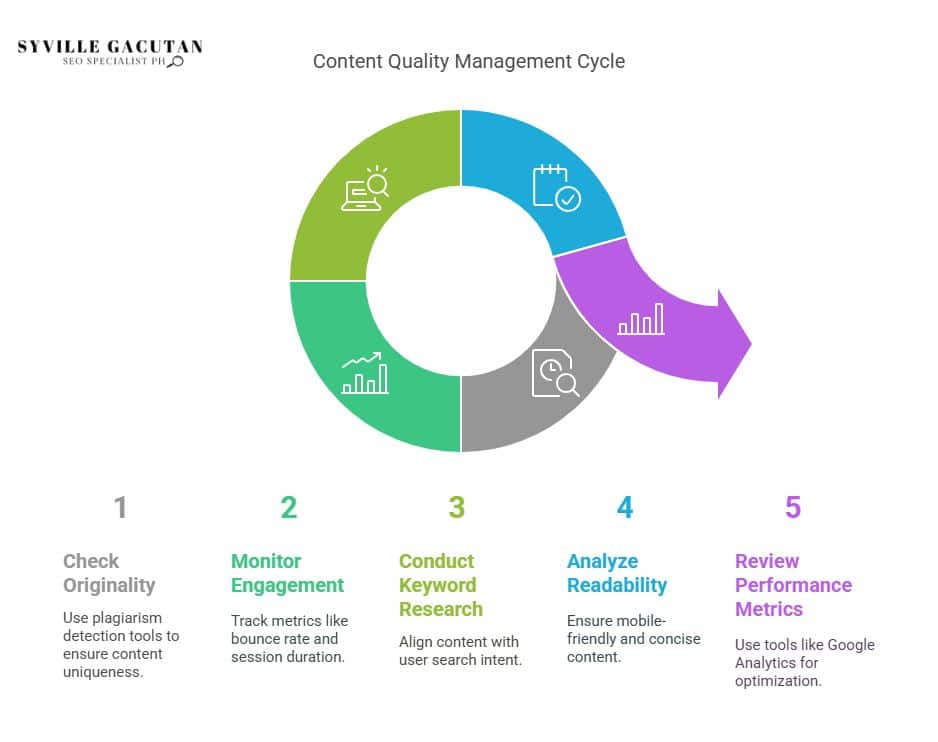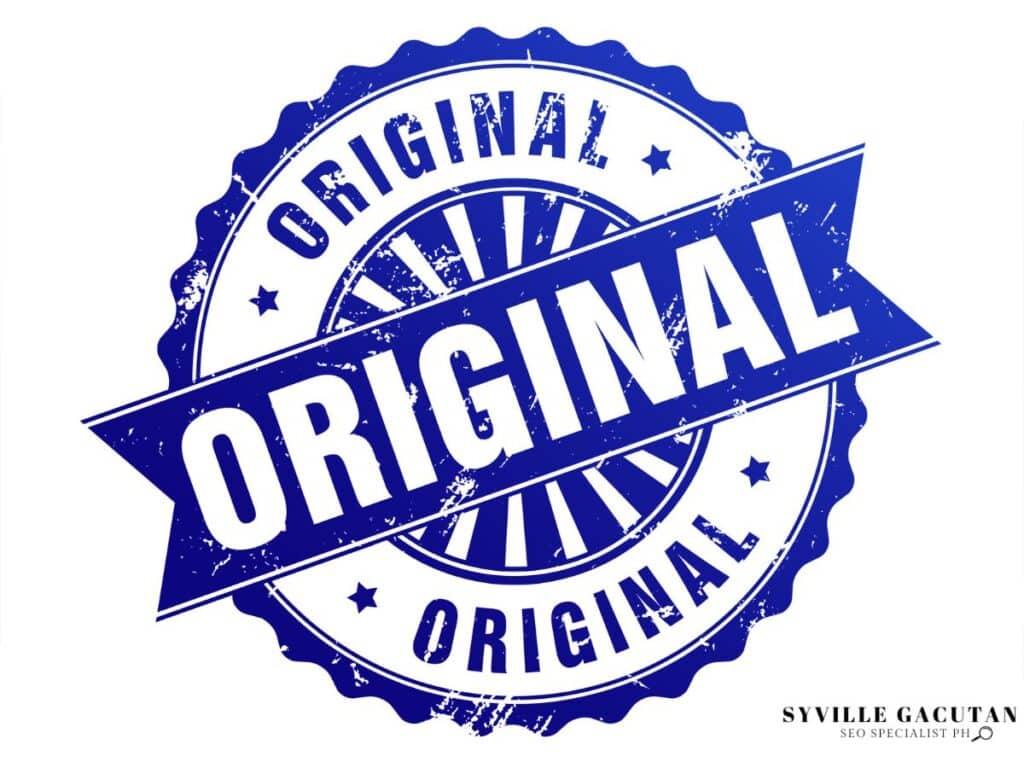
To assess content quality for SEO, start by understanding your audience through thorough keyword research and analyzing engagement metrics like bounce rate and session duration. Make sure the words you use match what people are searching for. Don’t force keywords into your writing. Let them flow naturally. Evaluate readability by keeping the language clear and sentences concise, tailored for easy mobile navigation. Originality is key; use plagiarism detection tools to maintain uniqueness and foster trust. Regularly monitor performance metrics such as CTR and dwell time with tools like Google Analytics to make data-driven improvements. These tactics aid strong search engine optimization methods. Also there exist further avenues for enhancing your content optimization properly.
Key Takeaways
- Use plagiarism detection tools to verify content originality and uniqueness.
- Monitor engagement metrics like bounce rate and session duration to assess content quality.
- Conduct keyword research to ensure content aligns with user search intent.
- Analyze readability and user experience for mobile-friendly and concise content.
- Regularly review performance metrics with tools like Google Analytics for optimization.

Understand Your Audience

To truly elevate the quality of your content for SEO purposes, it’s essential to zero in on understanding your audience. Crafting compelling SEO content hinges on understanding what your desired audience wants, how they prefer information and their typical online habits. This understanding directly impacts content quality, as it ensures that the material you produce is relevant, engaging, and valuable to your readers.
The first step to understanding your audience is to conduct thorough keyword research. This process involves identifying the terms and phrases that your audience frequently searches for, thereby allowing you to tailor your content to meet their specific needs. By aligning your content with these keywords, you not only improve its visibility but also enhance the user experience by delivering information that resonates with your audience’s interests.
Moreover, understanding your audience goes beyond mere keyword alignment. It requires a deeper dive into the demographic and psychographic characteristics of your readers. This includes analyzing factors such as age, location, interests, and challenges they face. By doing so, you can craft content that speaks directly to them, addressing their unique concerns and preferences, which in turn boosts content quality.
To optimize SEO content, consider the user experience at every stage. This means ensuring that your content is easy to navigate, visually appealing, and accessible on all devices.
Analyze Keyword Usage

Having a deep understanding of your audience sets the stage for effective keyword usage, which is a pivotal aspect of content quality for SEO. Achieving SEO content optimization necessitates a strategic approach to selecting and implementing keywords that resonate with your target audience.
By meticulously conducting content analysis, you can ensure your content aligns with user search intent, thereby enhancing visibility in search engine results.
An essential part of this process is developing a comprehensive content checklist that outlines your keyword strategy. This checklist should include primary and secondary keywords, as well as long-tail variations that reflect the nuances of your audience’s queries.
It’s crucial to assess keyword density and placement within your content to maintain a natural flow while maximizing SEO benefits.
To optimize your content effectively, integrate keywords organically into titles, headings, and body text. This enhances readability and ensures that keywords serve their intended purpose without compromising the integrity of your content.
Additionally, consider the semantic relevance of your keywords. Utilizing synonyms and related terms can broaden the scope of your keyword usage, thereby capturing a wider audience.
Regular content analysis is vital to measure the effectiveness of your keyword strategy. Utilize analytical tools to track keyword performance and make data-driven decisions.
This iterative process allows for continuous refinement and adaptation to evolving search engine algorithms and audience preferences.
Evaluate Readability
Readability is a critical component of content quality that significantly impacts SEO performance. Content that is easily understood not only engages users but also enhances their experience, leading to longer dwell times and reduced bounce rates. Moreover, search engines are increasingly sophisticated in evaluating readability, making it an essential aspect of content optimization. By focusing on readability, website content can avoid common SEO errors and achieve higher rankings.
To effectively evaluate readability, several factors must be considered:
| Factor | Description | Importance |
| Sentence Structure | Use of clear, concise sentences | Facilitates understanding and keeps readers engaged |
| Vocabulary | Use of familiar and simple language | Ensures that content is accessible to a broader audience |
| Paragraph Length | Short, focused paragraphs | Enhances readability and makes scanning easier for readers |
Sentence structure is paramount, as overly complex sentences can deter readers and result in poor engagement metrics. Quality content should employ clear and concise language, allowing users to grasp information quickly. Similarly, vocabulary should be straightforward, avoiding jargon unless necessary for the target audience.
Furthermore, paragraph length plays a vital role in readability. Short, digestible paragraphs enable readers to scan website content effectively, promoting a positive user experience. Balancing these elements is crucial in content optimization, helping to avoid SEO errors that can arise from poorly structured content.
Ensure Originality

Ensuring originality is a cornerstone of high-quality content and a crucial factor in SEO success. In the realm of digital marketing, originality distinguishes your content in a crowded online space. Search engines, particularly Google, prioritize unique and original content, rewarding it with higher search engine rankings. Consequently, originality is not just a matter of creativity but a strategic component of SEO optimization.
Crafting content for search engines requires a comprehensive analysis of existing material to ensure that your work stands out. Plagiarism, whether intentional or accidental, can severely impact your site’s credibility and ranking. Therefore, employing plagiarism detection tools is essential in verifying the uniqueness of your content. These tools compare your content against vast databases to identify any similarities, allowing you to make necessary adjustments.
Original content also enhances your site’s authority and user engagement. When users find fresh perspectives and insights, they are more likely to spend time on your site, share your content, and return for more. This user behavior signals to search engines that your site is valuable, further boosting your search engine ranking.
Furthermore, originality fosters trust. Audiences can discern when content is recycled or lacks authenticity. By providing original content, you not only improve SEO optimization but also build a loyal audience base. This approach aligns with the broader SEO strategy, where quality and authenticity are as critical as technical elements.
Check for Engagement

Assessing user engagement is a vital aspect of evaluating content quality for SEO. Engagement metrics offer invaluable insights into how well the content resonates with its audience. When content is engaging, it not only captivates visitors but also encourages them to spend more time on your site, interact with your material, and return for more.
This interaction is crucial as search engines like Google prioritize content that effectively meets the needs of its users, thus improving search engine optimization outcomes.
To determine if your content is achieving the desired level of user engagement, it is essential to monitor various metrics. Key indicators include bounce rate, average session duration, pages per session, and social shares. A low bounce rate and a higher average session duration suggest that visitors find the content compelling enough to explore further.
Likewise, an increase in pages per session implies that users are navigating through your site, indicating that your content is engaging and holds their interest.
Additionally, tracking social media engagement can provide further evidence of content quality. Shares, likes, and comments on platforms such as Facebook, Twitter, or LinkedIn reflect how well your content resonates with audiences beyond your website.
These interactions can lead to increased website traffic, further enhancing SEO performance.
Optimize for Mobile

Adapting content for mobile devices is a critical step in enhancing SEO performance, given the growing number of users accessing websites via smartphones and tablets. As mobile usage continues to rise, optimizing your website for these devices becomes indispensable. A mobile-friendly site improves user experience and is a significant factor in search engine results ranking. Google’s mobile-first indexing means that the mobile version of your site is prioritized, further emphasizing the need for seamless mobile optimization.
To achieve this, focus on on-page SEO and technical SEO aspects. Ensure that your website design is responsive, allowing content to adjust smoothly to various screen sizes. Streamlined navigation and fast loading times are crucial, as mobile users expect quick access to information. Content creation should be concise, engaging, and formatted for readability on smaller screens, which includes using larger fonts and ample spacing.
Here’s a table summarizing key mobile optimization strategies:
| Strategy | Description | Impact on SEO |
| Responsive Design | Adapts layout to different screen sizes | Enhances user experience |
| Fast Loading Times | Reduces page load speed | Improves search engine results |
| Streamlined Content | Simplifies and clarifies information presentation | Boosts engagement |
| Intuitive Navigation | Eases user access to content | Increases site usability |
| Mobile-first Indexing | Prioritizes mobile version for SEO | Affects rankings positively |
Monitor Performance Metrics

While optimizing your content is crucial for SEO, continuously monitoring performance metrics is equally important to ensure sustained success. Performance metrics provide valuable insights into how your content is performing in the digital arena, helping you make data-driven decisions to enhance your content strategy.
By leveraging advanced SEO tools, you can track key metrics like organic search metrics, bounce rate, and conversion rates, which collectively contribute to your understanding of how well your content ranks in search results.
Analytics platforms such as Google Analytics and SEMrush offer comprehensive insights into your website’s performance. These tools allow you to dissect various metrics, including page views, average session duration, and user engagement.
One of the most critical organic search metrics to monitor is the click-through rate (CTR), which indicates the percentage of users who click on your content after seeing it in search results. A high CTR suggests that your content is appealing and relevant to search queries, enhancing your ranking in search results.
Another essential metric is the dwell time, which measures how long visitors stay on your page after clicking through. A longer dwell time often correlates with high-quality content that meets user expectations.
Regularly analyzing these metrics enables you to identify trends, detect areas for improvement, and refine your content to better align with user intent.
Final Thoughts
Ensuring content quality for SEO requires a holistic approach, combining strategic keyword usage, readability, originality, and mobile optimization. By understanding your audience and creating content that is engaging and relevant, you not only enhance user experience but also improve your search engine rankings. Regular monitoring of performance metrics helps refine strategies over time, ensuring that your content continues to meet the needs of both users and search engines.
If you want to elevate your website’s content quality and achieve better SEO results, connect with Syville Gacutan, an experienced SEO Specialist in the Philippines. Syville can help you craft high-quality, search-optimized content, perform in-depth content audits, and ensure your website stands out in search engine rankings. Reach out to Syville today and take your content strategy to the next level!